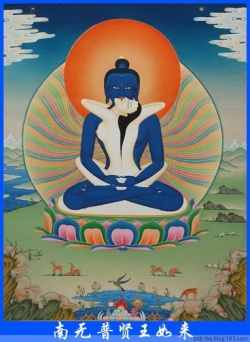Difference between revisions of "Adi Buddha a Buddhist deity"
m (Text replacement - "cult" to "{{Wiki|cult}}") |
m (Text replacement - "moon" to "{{Wiki|moon}}") |
||
| Line 6: | Line 6: | ||
| − | The {{Wiki|cult}} of [[Adi Buddha]] was at first accepted by the Kalachakrayana group of the [[vajrayana]] sect belonging to the [[Mahayana]] branch of [[Buddhism]]. The principal [[temple]] situated on the Swayambhu Mountain near {{Wiki|Kathmandu}} has been [[consecrated]] to [[Adi Buddha]]. According to a legend narrated in Swayambhupurana, [[Adi Buddha]] was first [[manifested]] in the [[shape]] of a flame. [[Buddhist]] {{Wiki|creation myths}} describe how [[Adi Buddha]] created the Avalokiteshvar, Maheshvar, [[Brahma]], Narayan, [[Saraswati]], the | + | The {{Wiki|cult}} of [[Adi Buddha]] was at first accepted by the Kalachakrayana group of the [[vajrayana]] sect belonging to the [[Mahayana]] branch of [[Buddhism]]. The principal [[temple]] situated on the Swayambhu Mountain near {{Wiki|Kathmandu}} has been [[consecrated]] to [[Adi Buddha]]. According to a legend narrated in Swayambhupurana, [[Adi Buddha]] was first [[manifested]] in the [[shape]] of a flame. [[Buddhist]] {{Wiki|creation myths}} describe how [[Adi Buddha]] created the Avalokiteshvar, Maheshvar, [[Brahma]], Narayan, [[Saraswati]], the {{Wiki|moon}}, the {{Wiki|sun}}, the wind, the [[earth]], and the ocean. |
[[Adi Buddha]] is considered to be the [[incarnate]] [[symbol]] of the [[void]] and the possessor of five kinds of [[virtue]] from which five kinds of [[meditation]] originated. From these [[meditations]] the five medidating [[Buddhas]] appeared. When [[Adi Buddha]] is represented in [[human]] [[form]], he is called Vajradhar. Representations of [[Adi Buddha]] Vajradhar show him in a seated position, with his legs crossed in a [[meditative]] vajrasan or in the sitting [[posture]] known as vajraparyanka. | [[Adi Buddha]] is considered to be the [[incarnate]] [[symbol]] of the [[void]] and the possessor of five kinds of [[virtue]] from which five kinds of [[meditation]] originated. From these [[meditations]] the five medidating [[Buddhas]] appeared. When [[Adi Buddha]] is represented in [[human]] [[form]], he is called Vajradhar. Representations of [[Adi Buddha]] Vajradhar show him in a seated position, with his legs crossed in a [[meditative]] vajrasan or in the sitting [[posture]] known as vajraparyanka. | ||
Revision as of 19:52, 12 September 2013
Adi Buddha a Buddhist deity, also referred to as Adinath (God, Creator, First Saviour) and Swayambhu Lokanath (He who saves the world through self-incarnation) or Swayambhu (Self-incarnated Lord). In Chinese Adi Buddha is called 'Pen-Chu-Fo' or 'Seng-Chu-Fo' which means 'First Buddha' or 'Progenitor Lord'. In Tibetan he is called 'Don Pohi-Sans-Ragyas' which means 'He is the Buddha of all Buddhas' or 'Machog-Gi-Don Pohi Sansa-Ragyas' which means 'He is the self-incarnated first Buddha' or 'Thogamahi-Sans-Ragyas' which means 'He is the first true Buddha'.
The Buddha did not include the divine in his teachings. buddhism is thus generally called an atheistic religion. The mahayana cult, however, introduced the divine in the form of Adi Buddha. According to this cult, Adi Buddha is the cause of creation, thunder, and of the void. He is described as omnipresent, omnipotent, and omniscient. The idea of Adi Buddha is believed to have originated in Bengal, from where it spread to other parts of India, Nepal and Tibet.
The cult of Adi Buddha was at first accepted by the Kalachakrayana group of the vajrayana sect belonging to the Mahayana branch of Buddhism. The principal temple situated on the Swayambhu Mountain near Kathmandu has been consecrated to Adi Buddha. According to a legend narrated in Swayambhupurana, Adi Buddha was first manifested in the shape of a flame. Buddhist creation myths describe how Adi Buddha created the Avalokiteshvar, Maheshvar, Brahma, Narayan, Saraswati, the moon, the sun, the wind, the earth, and the ocean.
Adi Buddha is considered to be the incarnate symbol of the void and the possessor of five kinds of virtue from which five kinds of meditation originated. From these meditations the five medidating Buddhas appeared. When Adi Buddha is represented in human form, he is called Vajradhar. Representations of Adi Buddha Vajradhar show him in a seated position, with his legs crossed in a meditative vajrasan or in the sitting posture known as vajraparyanka.
With his bodhisattva crown, fine dress and jewels, the deity looks like an Indian prince. His two hands are folded across his chest. He holds a lightning bolt in his right hand and a bell in the left.
Vajradhara has also been represented as a pair, especially when he is paired with power. This power of Vajradhar is named 'prajnaparamita'. These single and paired images have been variously explained. For example, the single image symbolizes the void, while the paired image symbolizes enlightened intellect; one is the living soul, the other is the eternal soul, etc. [Bhikhhu Sunithananda]
